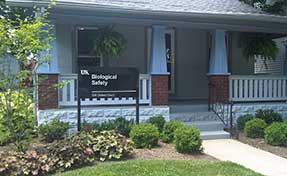Emergency Eyewash And Shower Equipment
General
The Kentucky Occupational Safety and Health Administration (OSHA) has adopted a modified version of the 1990 American National Standards Institute's Standard for emergency eyewash and safety shower equipment. OSHA requires: "Where the eyes or body of any person may be exposed to injurious corrosive material, suitable facilities for quick drenching or flushing of the eyes and body shall be provided within the work area for emergency use." The following outline the University's technical standards and preferences to provide safety equipment to meet this mandate:
- Plans and drawings must show location of safety shower and eyewash units; specifications must be provided for review & approval.
Physical Requirements for Emergency Safety Shower
- Emergency safety showers shall be located in an immediately accessible area within the laboratory unit or other work areas where the user shall not have to pass through a corridor door to reach the unit.
- Emergency safety showers shall be identified with a highly visible sign and a green cross located as an integral part of the floor directly under the shower.
- Safety showers installed in remote locations must be provided with an audible warning buzzer and visual alarm the audible and visual alarms shall be different than those used for fire, but the devices need not be larger or louder than those for fire alarms. The buzzer and visual alarm will be located above the door of the room with the shower. If feasible, an alternative alarm method connecting flow valves electronically to a twenty-four hour per day, seven days per week monitoring facility is preferred.
Physical Requirements for Emergency Eyewash Equipment
Emergency eyewash equipment shall ensure that a controlled flow of potable water is provided to both eyes simultaneously at a velocity low enough not to be injurious to the user following, as a minimum, the guidelines of ANSI Z358.1-1990.
- Emergency eyewash units shall be located in an immediately accessible area within the laboratory unit or other work area where the user shall not have to pass through a door to reach the unit.
- Emergency eyewash shall be identified with a highly visible sign and if floor or wall mounted, provided with a green cross located as an integral part of the floor directly under the eyewash or on the wall directly behind the eyewash unit.
- There shall be no sharp projections anywhere in the operating area of the unit.
- The unit shall be located to provide enough room to allow the eyelids to be held open with the hands while the eyes are in the water stream.
- The control valve shall be designed so that the water flow remains in the on position without the use of the operator's hands and must remain open until manually shut off. The valve shall be large enough to be easily located and operated by the user.
Emergency eyewash and shower equipment must be installed in every lab that is provided with a fume hood. Laboratories sharing a common suite or area not separated by closed doors may find one emergency shower is sufficient but each lab unit must be equipped with an approved eyewash.
You can contact the University of Kentucky Occupational Health and Safety Department for questions related to this guideline at (859) 257-2924.
Approved by UK Design Guidelines & Technical Standards Committee June 18, 1998.


